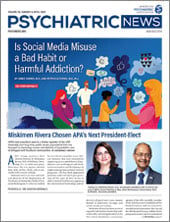The number of available match positions in psychiatry continues to increase, with nearly all positions consistently filled over the past five years, according to APA’s
2022 resident/fellow census. At the same time, although the number of residents pursuing subspecialty fellowships has increased over the years, a large number of subspecialty slots continue to go unfilled.
Those are among the takeaway messages from the census, a richly detailed portrait of the 2021 group of psychiatry trainees and the future of the psychiatric workforce.
The census is a product of the APA Division of Education and supported by the APA Division of Membership; it was compiled by Meghan Hophing, M.D., a fellow in the geriatric psychiatry program at New York Presbyterian Hospital, and Karuna Thomas, M.D., a first-year resident at the University of Massachusetts. They were mentored by Sanya Virani, M.D., an assistant professor and associate program director of the addiction psychiatry fellowship at the University of Massachusetts; Tanner Bommersbach, M.D., M.P.H., a child and adolescent psychiatry fellow at the Mayo Clinic; and APA Deputy Medical Director and Chief of Education Vishal Madaan, M.D.
The census compares 2021 data with the previous four years beginning with 2017.
A total of 1,907 psychiatry slots were offered in 2021, three of which went unfilled. That figure is up from 1,495 slots offered and 1,491 filled in 2017. The rising number of filled positions reflects the increasing popularity—and competitiveness—of psychiatry as a field. This trend has been accompanied by a decreasing percentage of positions filled by international medical graduates (IMGs). These physicians have traditionally worked in rural and underserved areas of this country.
“The APA resident/fellow census is an important resource that provides critical information related to the psychiatric workforce and helps guide our training programs with their recruitment and retention efforts,” said Madaan. “The report provides a range of useful demographics—age and gender, subspecialty-specific information, and recruitment trends over time.
“A heartening trend is the sustained fill rate of greater than 99% over several years and the growing number of women joining the psychiatric workforce,” he continued. “A clear challenge, however, is a lower percentage of international medical graduates that match into psychiatry.”
Of the 1,904 positions filled in 2021, 309 (16.3%) were filled by IMGs, down from 20.3% in 2017. The majority were filled by U.S. allopathic graduates (1,205, or 63.2%), osteopathic graduates (332, or 17.4%), and others (58, or 3%).
Racial and ethnic diversity among psychiatry trainees has remained largely unchanged over the past five years, but the number of non-U.S. citizen and Hispanic/Latino residents did increase in 2021. Among first-year general psychiatry trainees in 2021, 10.5% were Hispanic compared with 8.4% in 2020; 15.86% reported being non-U.S. citizens, up from 11.8% in 2020.
The number of residents pursuing subspecialty fellowships has marginally increased since 2017, with the greatest percentage increase in addiction psychiatry (20.7%). Still, a significant percentage of positions in subspecialty fellowships go unfilled each year. The occupancy rate for addiction, consultation-liaison, and forensic psychiatry fellowships averaged 64%, 60%, and 64%, respectively, over the last five years. Geriatric psychiatry had the lowest average enrollment rate of 33.5% from 2017 to 2021.
Other findings from the census include the following:
•
Among general psychiatry trainees reporting gender, the percentages reporting male or female has been nearly equal since 2017, with 50.2% female in 2021, up slightly from 48.9% in 2017. (In 2020, the Accreditation Council for Graduate Medical Education began reporting on a “nonbinary” category; to date, no trainees have identified as nonbinary.)
•
Among subspecialty fellows, the gender breakdown has been more variable: 41.6% reporting female for addiction psychiatry, 58% female for child and adolescent psychiatry, 46% female for forensic psychiatry, 56.9% female for geriatric psychiatry, and 58.4% female for consultation-liaison psychiatry.
•
The median educational debt for psychiatry trainees was $200,000, similar to that of residents in other specialties.
Thomas and Hophing said that the census should be read by anyone interested in the composition of the current trainees and the future of the psychiatric workforce. “The resident/fellow census provides a yearly snapshot of the psychiatry trainee population and also summarizes trends over the past five years pertaining to the National Residency Matching Program,” Hophing said. “It shows us important information on the recruitment and retention of psychiatry residents and fellows, as well as areas in need of greater [recruitment].”
APA first reported the demographics of psychiatry residents in 1969 through a survey of all psychiatry residency and fellowship programs and continued to survey programs annually until 1998. In 1999, APA collaborated with the AMA and used the AMA database of psychiatry residents to produce the 1999-2000 census report. Starting with the 2001-2002 report, APA’s data came from the National GME Survey or GME Track, an online survey conducted by the Association of American Medical Colleges in collaboration with the AMA. Additional data were gathered from the Accreditation Council for Graduate Medical Education Data Book and the National Residency Matching Program Data Resource. ■


